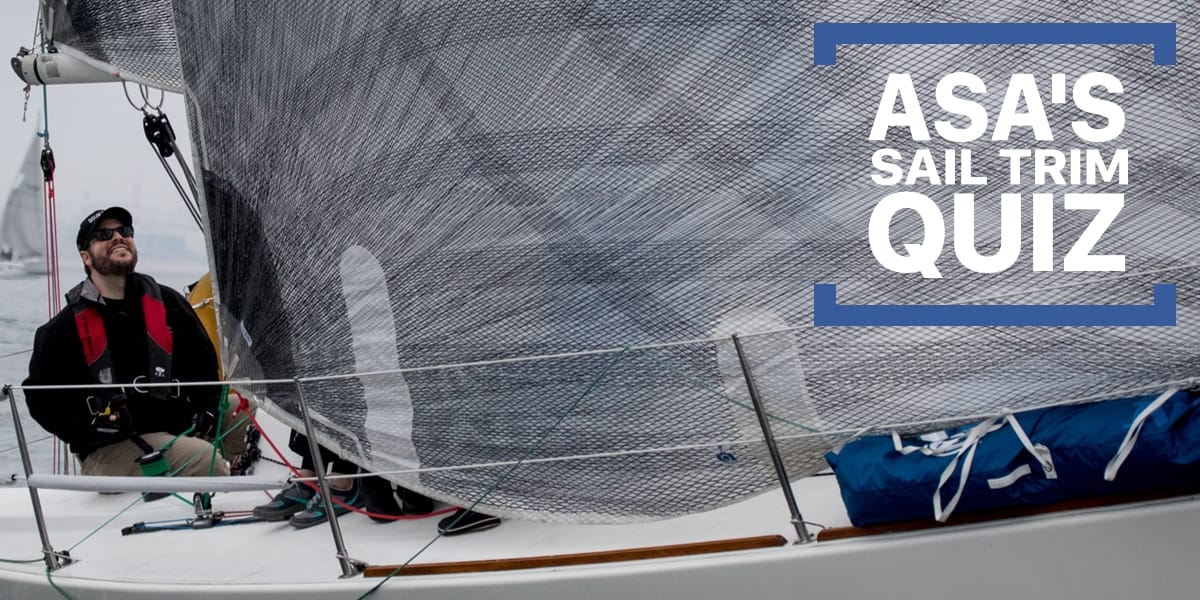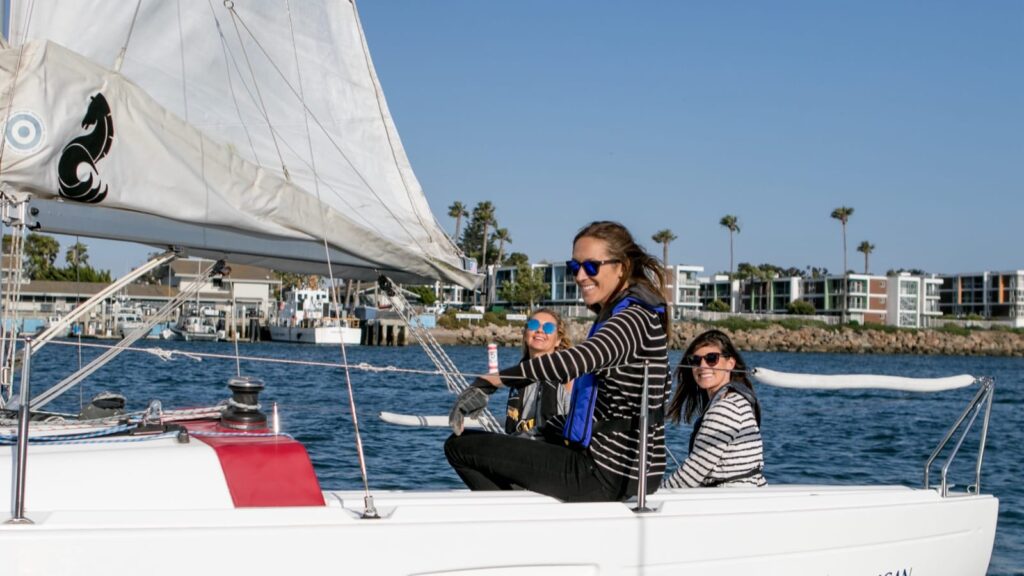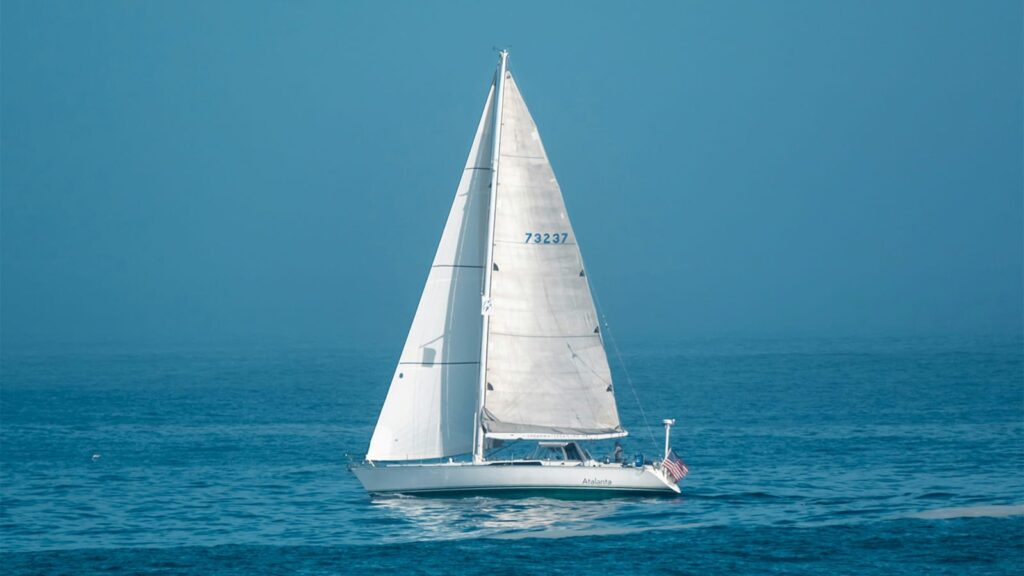Sail trim is a big part of a sailor’s knowledge base. Here’s a little quiz to see if you know some of the pertinents. Passing doesn’t mean you know it all and failing just means you have to hit the books. Have fun!
- Simply put, what does the word “draft” mean in terms of sail trim?
- The amount of wind that spills off of a sail, usually a mainsailNope! Hit the books!
- The measured force of wind hitting the sailsWrongo! Sounds like something out of a textbook but we invented that answer out of thin air!
- The measured angle of the headsail as it relates to the main on a sloop-rigged boatNot correct. Fancy sounding answer but not at all right…
- The curvature of a sail where the depth is the greatestWe knew you’d know!
The correct answer is D. Draft is the deepest point of a sail’s horizontal cross section the sail – it affects the amount of curvature (depth) in the sail’s airfoil shape. When we analyse sail shape we consider “draft position” – the location of the “deepest point” of the sail measured forward to aft along any cross section of a sail. - What is Twist?
- The difference between the angle of attack at the foot and at the head of a sailYes yes!
- The unwanted occurrence of a misshapen sail in a powerful gustNo, but we understand why you picked this.
- The technique of using the boom to pump a sail, thereby creating apparent wind in a light breeze.No, that’s just the day you realize you need an outboard!
- The length of the foot of a sail multiplied by the draft equals its twist.‘fraid not. Twist is not some weird math problem.
The correct answer is A. Twist is the difference in angle of attack (chord) of the horizontal cross section of the sail at different heights. Normally it is measured from the bottom (which is zero degrees) to the top of the sail (or any other height). - The most common reason for weather helm is:
- Strong currentsThat is not the most common reason
- Winds so light the boat follows its natural tendency to move to windwardUhhh, no.
- Excessive heelThat’s right! Adjust your trim or consider reducing sail area!
- Uncalibrated linkage within the steering systemUncalibrated linkage? No…
The correct answer is C. The most common cause of weather helm is excessive heel while sailing upwind or close reaching. The difference in position of the center of effort of the sails relative to the center of lateral resistance (pivot point) of the hull causes weather (or lee) helm. Factors include, mast rake, mast step position, sail shape, sail size and trim, and how much the crew is hiking! Normally a small amount (3-5 degrees) of weather helm is desirable when sailing upwind in moderate winds. - “Pinching” means:
- Pointing too high into the windBut of course!
- The constant readjusting of sails when traveling up windNo, that’s just OCD!
- Adjusting the traveler to the windward side of the center pointYou are incorrect! Adjusting the traveler does not a pinch make!
- Making your sails as flat as they can beNope – nothing to do with sail shape…
The correct answer is A. “Pinching” means sailing too close to the wind direction when trying to sail upwind. There are times where you my intentional to “pinch” (to get round an object, or in a strong puff of wind) but it is not the most efficient way to sail upwind. - What is a Preventer?
- A Preventer is a another name for a life lineIt could be but it’s not
- It’s the post that keeps the rudder from spinning around in a circleNo, but it’s kind of funny you thought that.
- It’s the last thing a mainsail hits after being raisedThat does prevent but it’s not a preventer.
- A system rigged so the boom doesn’t accidentally jibeThat is very right.
The correct answer is D. A preventer is a system (ropes and straps) that prevents the boom from jibing. It can cause a boom to break in an accidental jibe and normally should not be employed. Always keep your head and body below the boom’s arc of rotation! - When sailing close hauled, a general rule for mainsail trim is to:
- Have the outboard end of the top batten parallel with the boomNice work!
- Have the outboard end of the bottom batten curved at a 30-degree arcThat is not a general rule.
- Have the luff tension loose because you can always go tighter later if need beThat is not a good idea.
- Adjust the luff tension in concert with mainsheet tension until a perfect aerodynamic slot is formedDon’t do that…
The correct answer is A. A general rule for setting upwind mainsail twist is to have the boom on or close to centerline and the top batten (at the leech) parallel (but not directly above) to the angle of the boom. - In what order should you trim sails on a sloop-rigged boat?
- Main then jibNo, you need to change your ways
- Jib then mainYes!
- It doesn’t matterIt does! Wrong…
- Both as close to simultaneously as possibleNo, there’s a better answer
The correct answer is B. For best performance and acceleration – trim the jib a second or two ahead of the mainsail. However, in most conditions it really doesn’t matter which sail is trimmed first. But to avoid getting stuck in irons in stronger winds – never trim the mainsail before the jib.
Click on an answer above to start!








